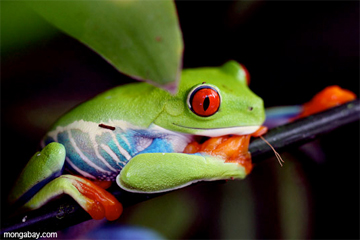Scientists find a possible cure to a disease that has been devastating frogs, toads, salamanders, newts, and caecilians worldwide.
Scientists have discovered that a species of zooplankton will eat a fungal pathogen that is killing amphibians around the world.
Researchers at Oregon State University found that Daphnia magna, a freshwater microorganism, will consume the zoopore or the free-swimming stage of the “chytrid” fungus. The discovery opens the door for a possible biological solution to a problem that has confounded ecologists.
“We feel that biological control offers the best chance to control this fungal disease, and now we have a good candidate for that,” said Julia Buck, a doctoral student in zoology at and Oregon State University lead author of the study, which is published in Biodiversity and Conservation. “Efforts to eradicate this disease have been unsuccessful, but so far no one has attempted biocontrol of the chytrid fungus. That may be the way to go.”
 Red-eyed tree frogs seem to be less affected by the disease. Photo by Rhett A. Butler |
Buck and colleagues suggest that Daphnia magna could reduce the density of B. dendrobatidis, the chytrid fungus, enough to enable amphibians to fight off infection.
Chytrid has been moving across key habitats like a plague. While scientists have been unsure what is driving its spread, some suspect accidental introduction by researchers, tourists, and forest workers. Chytrid is blamed for the extinction of dozens of species of frogs and toads over the past 20 years. Its presence has been linked to declines in other amphibians as well.
“About one third of the amphibians in the world are now threatened and many have gone extinct,” said Andrew Blaustein, a professor of zoology and co-author. “It’s clear there are multiple threats to amphibians, but disease seems to be a dominant cause.”
Related articles
Scientists scramble to save dying amphibians

(04/28/2011) In forests, ponds, swamps, and other ecosystems around the world, amphibians are dying at rates never before observed. The reasons are many: habitat destruction, pollution from pesticides, climate change, invasive species, and the emergence of a deadly and infectious fungal disease. More than 200 species have gone silent, while scientists estimate one third of the more than 6,500 known species are at risk of extinction. Conservationists have set up an an emergency conservation measure to capture wild frogs from infected areas and safeguard them in captivity until the disease is controlled or at least better understood. The frogs will be bred in captivity as an insurance policy against extinction.
Bad news for frogs; amphibian decline worse than feared

(04/16/2007) Chilling new evidence suggests amphibians may be in worse shape than previously thought due to climate change. Further, the findings indicate that the 70 percent decline in amphibians over the past 35 years may have been exceeded by a sharp fall in reptile populations, even in otherwise pristine Costa Rican habitats. Ominously, the new research warns that protected areas strategies for biodiversity conservation will not be enough to stave off extinction. Frogs and their relatives are in big trouble.